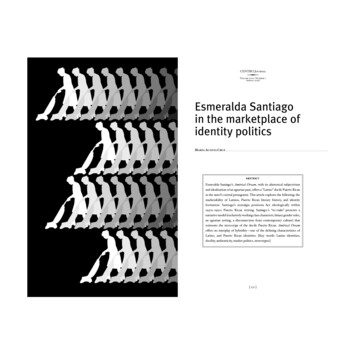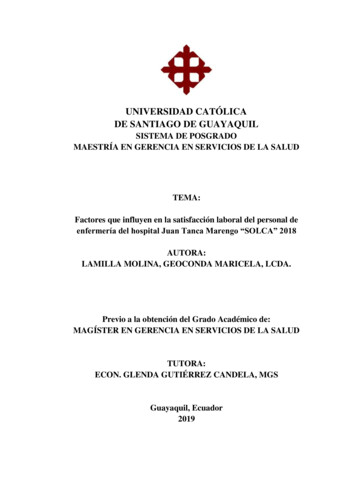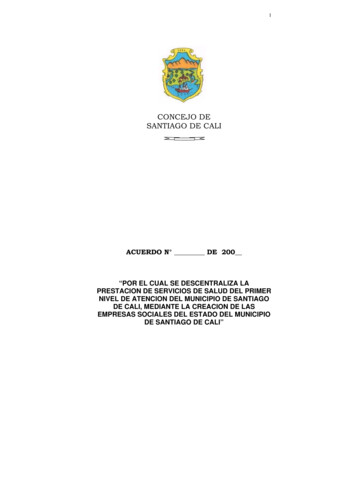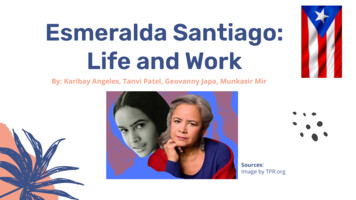
Transcription
AcostaCruz(v2).qxd7/15/063:21 PMPage 170CENTRO Journal7Volume xv1ii Number 1spring 2006Esmeralda Santiagoin the marketplace ofidentity politicsM ARÍA AC O S TA CRU ZABSTRACTEsmeralda Santiag o ’s América’s Dream, with its ahistorical subjectivismand idealization of an agrarian past, offers a “Latino” docile Puerto Ricanas the nov e l ’s central protagonist. This article explores the following: themarketability of Latinos, Puerto Rican literary history, and identityformation. Santiago’s nostalgia positions her ideologically within1930s–1950s Puerto Rican writing. Santiag o ’s “te r ruño” presents anarrative model (exclusively working class characters, binary gender roles,an agrarian setting, a disconnection from contemporary culture) thatreinvents the ste r e o t ype of the docile Puerto Rican. América’s Dreamoffers no interplay of hybridity—one of the defining characteristics ofLatino, and Puerto Rican identities. [Key words: Latino identities,docility, authenticity, market politics, stereotypes][ 171 ]
AcostaCruz(v2).qxd7/15/063:21 PMPage 172“Desde el fabuloso “retorno a la tierra’ de L acarreta, [ ] la añoranza e idealización de lasociedad agraria patriarcal de La víspera delhombre, hasta el subjetivismo ahistórico de‘El puertorriqueño dócil’ y La mirada, la [ ] obra deRené Marqués constituye la [ ] búsqueda de un‘tiempo perdido’ e irrecuperable en definitiva pormedio de la nostalgia militante.” (González 1989: 84)This epigraph from José Luis González about René Marqués could applyto Esmeralda Santiago, whose oeuvre takes the traits of ahistoricalsubjectivism, nostalgia, and idealization of an agrarian past, into theLatino context and gives a new face to a well-known über-Latinostereotype: the docile Puerto Rican. The high visibility of her workmakes for a repetition and reinvention of some of the most troublingstereotypes about Puerto Ricans and Puerto Rico.workers and their interaction with people in other spheres of life; for example(teacher’s assistant) Tere Avila’s partnership with (over-educated and ambitiousaccountant) Irma Granados in Loving Pedro Infante.I contend that in the marketing of Puerto Rican identity Santiago is what RenatoRosaldo called the “Lone Ethnographer” (31), i.e., someone who offers an “objective”overview of a culture as a homogeneous, unchanging monument. What gives onepause is the anthropological reading encouraged by the publicity surrounding herwork: the reader is supposed to approach her “authentic” descriptions of Puerto Ricoas if they were ethnographies. Some academic critics also support this view, forexample Rodríguez Vechinni refers to her work as “ethnografic autobiography” (174).As Lori Ween explains: “the appearance of authenticity and the belief in the truthof a created image are vital and are manufactured to create a bond of trust with theaudience” (92). The culture industry ensures the reception of Santiago’s Puerto Ricoas “authentic” because it is taken as grounded in autobiography, which is already aproblematic viewpoint for identitary projects. Her strategy relies to a great extenton authority of experience as the source of cultural and historical informationpertaining to Puerto Rico and Puerto Ricans with little or no references to othersources of authority. This means that Santiago is, in essence, true to herself.However, even a cursory glance at the paratextual (ancillary) material that promoteSantiago’s works—such as web pages, reviews, jacket art, interviews, etc.—shows thestress laid on the authenticity of the works’ Puerto Rican and Latino experience.Cynical as it may seem, can we ignore in our reception of Santiago the commercialhype of, say, the web pages devoted to her life and work?4 A publicity machine thatpromotes readings of her version of Puerto Ricans as ethnically “real” bypassesnotions of accountability to historical facts and actually promotes a product thatwoefully disregards Puerto Rican complexities.Critics have pointed out the centrality of Puerto Rican identity in her work.Aileen Schmidt affirms, “The problem of identity is the cornerstone of thenarration” (136). Carmen L. Torres-Robles sees that cornerstone as tied to herpuertorriqueñidad: “Su sentido de identidad nunca se ve amenazado con la influenciade la cultura norteamericana” (210). Keith Alan Sprouse restates this by saying that,in her memoirs, “although she claims to have once wanted to be North American,in the final instance, when she speaks of her island, her people, and her language,she refers only to Puerto Rico, Puerto Ricans, and Spanish, finding no place forNorth America, North Americans, or English” (115). But he does not delve intowhat kind of “Puerto Rico” is at issue in her works.The marketplaceSantiago is a prominent member of the Latina boom in United States publishingof the 1990s.1 Common to their work (and that of their male counterparts) is theexploration of Latino identities. It is important to weigh the significance of a Latinabeing her own cultural agent and representing her wo r l d v i ewon her own terms.Yet it is equally important to remember the part Santiago plays in the culturalphenomenon of the U.S. “ethnic identities” market. Top Latina writers such asSantiago, Sandra Cisneros, Denise Chávez, Julia Alvarez, and Cristina Garcia have theirworks published by major houses, and are rewarded with literary prizes; and sometimestheir works are made into movies, thereby institutionalizing them into canon-formingcultural products. Market forces turn their works into commodities that speak to thevogue for all things Latino in contemporary U.S. culture. Santiago is a star in thatmarket—proof is the PBS presentation of Almost a Wo m a n.2 She is not a disenfranchisedhomegirl from the barrio. Her cultural clout is shown by the frequency with which hertexts appear in high school and college-level readers and textbooks, proof of the accessshe has to the means of cultural production. She is visibly located at the center of aculture industry that thrives on representations of “Latinoness.”For an author who came to prominence in the 1990s, it is striking how she dealsin a kind of identity formation. For the most part her texts ignore alternate forms ofP u e rto Rican experience and values— e x cept for her own—rendering a uniform identitythat conforms to ste r e o t ypical expectations of a “certain” kind of Puerto Rican: i.e.,uneducated and working-class. Ellen McCraken calls this kind of cultural production“successful ‘minority commodities,’ versions of the Latino Other that mainstreampublishing companies authorize, market, and even, to some degree, foment” (5).The working-class has rightfully occupied the lion’s share of Latino literaturebecause great numbers of Latinos in the United States are from the working-class.Yet Santiago’s works present “Puerto Ricans” as synonymous only with members ofthe working class.3 Compare for example Denise Chávez’s focus on “service” industryThe problematics of authenticityOn a theoretical level Cervenak and colleagues state that “the very discursivepractice of ‘authority of experience’ replicates, however oppositionally, the politicsof state domination” (351). So if we set aside the belief in primacy of experience andfocus on the culture represented in her works, Santiago’s rendering of Puerto Rico—taken as gospel truth by so many readers in the States because it “flows” fromautobiographical expertise—is seen to be far removed from historical and culturalPuerto Rican reality. It amounts to authenticity by implication.Santiago’s oeuvre should be identified with what José Luis González labeled jibarismoliterario (González 1989: 37), by which he meant the mythification of the small town PuertoRican peasant. The cultural appeal of this presentation of Puerto Ricans is exemplified bythe long-held popularity of Rafael Hernández’s 1929 song “Lamento Borincano”[ 172 ][ 173 ]
AcostaCruz(v2).qxd7/15/063:21 PMPage 174(“Y triste, el jibarito va / pensando así, diciendo así / llorando así por el caminooooo”).The impact (through massive marketing and exposure) of that vision, in thecontext of a Latino search for roots, is that Puerto Rico is perpetuated for, say,great numbers of high school and college students in the U.S., as a 1950s agrarianlost land. All of the island’s complexity, what José Luis González called “la complejay conflictiva realidad puertorriqueña” (González 1987: 149), is also lost.Who in América?I want to focus on Santiago’s one “pure” fiction novel, Am é r i ca’s Dream, in orderto discuss the repercussions of her portrayal of Puerto Rico and Puerto Ricanidentity even when not directly linked to “a u tobiography.” This novel, though cas tentirely as “fictional,” characterizes Puerto Rico in the same terms as the twomemoirs and represents itself as grounded in the “real” experience of Puerto Rico .For example: in the acknowledgments page Santiago states that “while this is awork of fiction, it takes place in Vieques, which is real.” Then the author thanksthe owners of a real hotel in Vieques called La Casa del Francés, “for theirhospitality and generosity in allowing a fictional América Gonzalez to work intheir lovely hotel.” This sets the stage for the textual scheme that follows, to wit:naturalism mediated by melodrama. Her “picture” repeats and solidifies a specificview of Puerto Rico: a 1950s- l i ke, patriarchal agrarian paradise spoiled bymodernity in which an abused but beautiful wo r k i n g - c l ass woman lives in a cycle ofoppression from which she runs away (to the U.S.), only to be hunted by the machoman she sought to escape. The novel’s strategic underpinning, a mix of melodramaand naturalism, allows Santiago to revisit her project and sell to the reading publicthe “real” face of Puerto Rico (as she sees it).In this novel Santiago repeats the mas s-appealing and melodramatic plot stratag e mof a long-suffering working class heroine. Santiago, as a sort of ‘90s Corín Tellado,amply demonstrates the marketability of ste r e o t ypes when presented through a 1970sf l avored, Second Wave feminist viewpoint. I contend that Santiago’s use of patriarchalmelodrama does not participate in a subversive use of melodrama as re-vision of LatinAmerica (for example, how Denise Chávez throws into question filmic melodrama inLoving Pedro Infa n t e). For Santiago, melodrama reflects Puerto Rican culture as aManichean conflict of binaries. What is striking about Santiag o ’s work is the presenceof unexamined dichotomies: male/female, and Puerto Rican/American.América’s Dream offers a comforting view of old-fashioned puertorriqueñidad thatreverts in most particulars to the stereotypes of poor, passive, docile, uneducated,and downtrodden Puerto Ricans (both on the island and in the States), who are seenas no threat to anyone in the established order.Far from presenting the “big picture” of Puerto Rican society—which would makeher a Nuyorican Balzac or even a Rosario Ferré—in América’s Dream Santiago depictsa univocal “Puerto Rico” bounded by strict divisions of class and educational level,and the working class protagonist remains as isolated from contact with other castesas any sub-continental untouchable. Santiago’s portrayal of Puerto Rico suffers fromcultural essentialism, which Uma Narayan explains this way: “While culturallyessentialist feminist representations of ‘Third World cultures’ sometimes depict thepractices and values of privileged groups as those of the “culture as a whole” [ ]equally essentialist representations are produced when the ‘Representative Third WorldWoman’ is modeled on marginalized and underprivileged Third World women” (84).Crucial to this representation is how Santiago glances at Puerto Rican history:[ 174 ]through the prism of romantic nostalgia, a telluric imaginary that has stood her wellin the marketplace. Her texts stage a Macondoized5 Puerto Rico, which in this novelis set in Vieques, thus telescoping the insularity to an island off the coast of an island.Early in the novel there is a telling description of Vieques:Once these lowlands were a sea of sugarcane, which elegantseñores oversaw atop sprightly Paso Fino horses. But when theU.S. Navy appropriated two-thirds of the island for itsmaneuvers, the great sugar haciendas disappeared and the tallstacks that dotted the island were bulldozed out of the way.This is history, and América doesn’t think about it (17).This stunted historical picture of a model nineteenth-century graceful patriarchallife is the text’s construction of history, not the protagonist’s. The glaring irony of amaid, herself the descendant of servants, being located within a nostalgic vision ofruling class splendor is nonsensical since América is a working-class woman in aworking-class world. This re-territorialization of Puerto Rican identity is dependenton a place, Vieques, which sustains a textual yearning for a patriarchal vida señorial—a dreamland already co-opted by Puerto Rican politicians and successfully marketedby banking and rum corporations since the 1970s. The reference—without apparentirony—to the proud and tall stacks of the sugar haciendas is estranged from theeconomic history and class issues of the sugar industry in the Caribbean. As José LuisGonzález never tired of explaining, the “hateful” haciendas—which he described ashaving emerged from “la subcultura extranjerizante y parasitaria de los hacendadoscorsos, mallorquines y ‘peninsulares’ de idéntica laya expoliatoria” (González 1987:150)—were never a “telluric” element but a foreign, oppressive structure created bywhat he would have called the (two) “metropolis.”6The retro vision of Puerto Rico is closely linked to Santiago’s adherence to whatGonzález called “independentismo tradicional” (González 1989: 25), which presenteda mythified view of Puerto Rican cultural and social unity in the nineteenth century.For González the world of the haciendas was a false “epítome de la ‘puertorriqueñidad’”(González 1989: 23). Yet the text looks back fondly on the haciendas.As to the reference in the passage quoted earlier to “the sprightly Paso Fino horses,”José Luis González identified the same horses as symbols of the patriarchal order insuperannuated notions of Puerto Rican identity:El telurismo característico de la literatura producida por la élitepuertorriqueña en el siglo XX no responde [ ] a unadesinteresada y lírica sensibilidad conmovida por las bellezasde nuestro país tropical, sino a una añoranza muy concreta ymuy histórica de la tierra perdida, y no de la tierra entendidacomo símbolo ni como metáfora sino como medio deproducción material cuya propiedad pasó a manos extrañas.En otras palabras: quienes ya no pudieron seguir “volteando lafinca” a lomos del tradicional caballo, se dedicaron a hacerloa lomos de una décima, un cuento o una novela (González 1989: 33).[ 175 ]
AcostaCruz(v2).qxd7/15/063:21 PMPage 176Juan Flores writes that a certain brand of Puerto Rican nationalism is a vehicle for“obviously conservative metanarratives of moral puritanism, elitism, patriarchy, andheterosexism” (33). Given that Santiago’s subject matter is the diasporic experienceof Puerto Ricans, the text adheres to an essentialist presentation of identity(national, class, and gender-based), over which América’s old-guard patrioticindependentismo presides as a key conceptual instrument of Puerto Rican identity.The text ignores any discussion about Puerto Rican “nationhood” or of the hybridconstruction of identities of Puerto Ricans in and out of the island.Santiago’s univocal portrayal of Puerto Rico is in part due to a commonphenomenon: exilic nostalgia for the past. Flores notes the heightenedpatriotism/nationalism shown by many Puerto Ricans in the mainland, which hecharacterizes as a “paradoxical inversion of geographic location and culturalbelonging” (53) because “people, say in Guaynabo, take their culture for granted,while others in Philadelphia defend it passionately” (52); he uses as a model for thiscultural occurrence the famous casitas in the Bronx and Brooklyn. Santiago’s nostalgiafor the terruño positions her ideologically within the generation of Puerto Ricanwriters of the 1930s through 1950s—theoretically in such exalted company asAntonio S. Pedreira and René Marqués—who looked back with nostalgia on thehacienda economy.7Santiago’s negotiation of identity falls back on a “pure” independentismo thatresists the issues about the island’s status long debated by writers and critics bothon and off the island. Her insistence on the independence ideal as central to theformulation of puertorriqueñidad appears with América’s contact with Latinos fromother national origins. This happens in the chapter called “Las Empleadas.” AfterAmérica states that she doesn’t consider herself an American, asserting “I’m notAmericana I’m Viequense” (218) (she means “Puerto Rican” since Santiago placesher text in Vieques as the last outpost of that particular puertorriqueñidad), Américathen “tells them [the empleadas] that where she comes from people are fighting to winindependence from the United States” (253). This act of suppression ignores thedecades-long failure of the independence movement at the Puerto Rican polls.Absent from Santiago’s cultural radar is the long discussion of that failure; how, forexample, in 1960 René Marqués bemoaned the imminent death of the independentistaparty, which he called the “P.I.P en naufragio” (203), or how in 1980 José LuisGonzález blasted the ideology of traditionalist twentieth-century independentismo,which was for him a product of the culture of the nineteenth-century ruling classes.The past decade has seen increased discussions about the viability of theindependence ideal. On one side are neonationalist theorists (who affirm it) and onthe other so-called postmodern culture critics (who believe it has been superceded).8Yet in 1996 América’s Dream uses what Ana Lydia Vega once called “el independentismotirapiedras de los sesenta” (16): a rote, unquestioned assertion of independence as aco n te m p o r a ry “goal” of the Puerto Rican “people.” This claim makes Santiago’simaginary Puerto Rico distant from the complex sociopolitical realities of theisland. It is as if the political views of the protagonist were learned from the sce n ein When I Was Puerto Rica n, where Negi discusses the island’s situation with herindependentista father in the 1960s, which is surprising given that America’s Dreamis set in the 1990s.Juan Flores summarizes the wide-ranging discussions toward the end of thetwentieth century about Puerto Rico’s political status and their impact on PuertoRican identity:América’s Dream affirms a neo-jíbara mentality that rejects notions of the hybridityof Puerto Ricans. Later in the novel, América’s residence in “America” also precludesnotions of change for Latinos.Puerto Rico is formulated as a nostalgic dreamland, where a utopian social spacehas been replaced by the evils of modernity. When América remembers her Viequesneighborhood, she recalls how in her childhood “every house was set back behindbroad yards, surrounded by mango, breadfruit, and avocado trees. Before urbanization.They didn’t have running water then, or electricity” (25). One can’t help getting theimpression that, for Santiago, the fruit was worth the lack of modern conveniences.The protagonist reverts to genealogy as the source of historical memory;América is the latest in a long line of working peons oppressed by the haciendasuperstructure, yet she romanticizes and identifies with an oppressed ancestress:“América is the daughter of the great-great-great-granddaughter of the resourcefulMarguerite” (77), the housekeeper the patriarch of La Casa del Francés took as hislover. Rather than highlight the oppression of Marguerite (that earlier maid),the only other pseudo-historical passage in the novel dwells in melodrama andpresents the romantic history of Marguerite, in which the servant girl lands thepatriarch (cf. 77). Later, when América dreams of a second flight to freedom,she figures she will take on the identity of that ancestress and change her name toMargarita Guerra (cf. 287), thus ensuring the symbolic continuance of a heritage ofoppressed women natives whose only possibility of moving up in the world is takenas being married to a man of the “right class”—more or less what América hopesher daughter will do.9 La Casa del Francés itself, with its colonial architecture(broad veranda, mosaic floors, hammocks, wicker and rattan chairs, central courtyard withsinging birds in a cage, cf. 35) is a synecdoche of the glory that was el Puerto Rico señorial.Santiago keeps the characters firmly away from the social unrest that was thena condition of life in Vieques. The novel makes token references to the situation;one night América hears the distant thud and feels the ground tremble when theNavy is using the eastern shore of the island for target practice (cf. 64, 65). Later,when América muses on the protests against the Navy presence, which she rightfullysays were “commonplace,” she respects the protestors’ commitment but cannot bea participant since she remains bound to her man, Correa, who true to form tellsher “women should stay out of politics” (253), which keeps her from participating.The novel’s strategic use of geography triangulates Vieques between Puerto Ricoand the United States, with Vieques as the last cultural outpost of Santiago’simaginary Puerto Rico. Whatever modern conveniences may have arrived from the“big island,” here Vieques (about as far as you can retreat from the “big” island andnot drown) stands as the last bastion of a narrowly defined territorial culture.If the “big island” is far removed from the characters’ lives, even further away is theU.S.; when America’s mother Ester mentions sending her daughter Rosalinda torelatives in New York, “Ester could as easily have suggested she send Rosalinda to[ 176 ][ 177 ]Over against the “essentialism of the neo-nationalistdiscourse,” this line of recent criticism poses the “culturalhybridity (heterogeneity and plurality) of our contemporarycultural formation,” the profound contradictions inherent inthe national construct, and its unboundedness and relationalinteraction with other “national” cultures (33–34).
AcostaCruz(v2).qxd7/15/063:21 PMPage 178China, and América would have responded with the same astonishment, the sametrembling fear of the distance between Vieques and anywhere else in the worldfarther than Puerto Rico, which seems far away enough” (66).In Am é r i ca’s Dream Santiago withdraws with single-minded logic to thefurthest geographical location in Puerto Rico, one that has a stretch of oceanbetween it and the “mainland,” and that far locale is the setting for areenactment of the conditions that permeated the Puerto Rico of When I WasPuerto Rica n, an agrarian, dirt-poor, underprivileged setting fit for Santiag o ’sunderdeveloped Puerto Ricans. América is island bound and ignorant of anyother life since the furthest she’s been is to Fajardo “and she stayed there amonth, hiding out in the same house where Rosalinda now lives with Correa’saunt and cousin” (117).A s t r a tegic lynchpin to the far-awayness of Santiag o ’s Puerto Rico is thealmost co m p l e te lack of references in her texts to co n te m p o r a ry Puerto Rican orU. S. cultures. For example, América’s Dream displays an almost total unawarenessof that all-consuming Puerto Rican pastime: local politics. One of the fewexamples of culture as a reference point for the sto ry is when the novelr e i n f o r ces the cultural quagmire of domestic violence by mentioning anunnamed merengue about a man whose “wife went to New York and now thatshe’s back, she wo n’t do his laundry, wo n’t cook his meals, and won’t have sexwith him unless he speaks to her in English” (71). However, the text does notdelve into the connections between diasporic identities, misogyny, and popularmusic. The novel also refers to popular T V shows such as Cristina Saralegui’s(U. S. - p r o d u ced) talk show and mentions that A m é r i c a ’s mother watchestelenovelas endlessly. In a brief nod to the media’s disto rtions of everyday PuertoRican life, at the end of the novel Ester herself achieves celebrity when sheappears on Cristina’s show about domestic violence and its effects on familymembers. Even though there is mention of Lorena Bobbitt and O.J. Simpson(signs of the constant flow of U. S. mainstream culture on Puerto Rican dailyculture in the 1990s), logic is tossed aside when América rides her first trainin the U. S. yet has no point of reference to co n te m p o r a ry life in the U. S.:“her image has been formed by the iron black locomotives in we s terns” (180).This kind of strategic ignorance about life in the U. S. repeats the text’savoidance of culture “out there” and of the effects of the media, which,for good or ill, binds the island to the life of the U. S. (as represented by said media).América is co m p l e te ly out of touch with daily life in the United States,one of the most common points of reference for the discourse of everydayPuerto Rican life. Her trip to the States, a “journey into darkness” is as to“a foreign country where they speak a language I barely comprehend” (133),where she arrives wearing a thin dress and high heels in February. Her problemin adapting to her residence in the States goes beyond her lack of English.The character is so provincial that she’s surprised when she hears other Latinosspeaking Spanish with an accent unlike hers (cf. 164), which is illogical giventhat she lived in a house where telenovelas were constantly on the T V screenand most of these are produced in other Latin American countries. This strate g i ci g n o r a n ce reduces A m é r i c a ’s already limited experiences and shapes her docility.When her would-be Nuyorican lover Darío takes her to the circus she is“embarrassed that she feels like a kid who has never seen anything, has neverbeen anywhere, and didn’t know there were such marvels in the world” (259).Santiago’s lack of interest in mass or popular culture is a phenomenon that speaksto her refusal to portray Puerto Rico’s complex history and contemporary reality aswell as the hybrid identity of Latinos. In part this blank textuality that refuses toinclude culture “out there” is motivated by the characters’ attachment to themicrocosm of La Familia, to the fact that their world begins and ends in a small-townview of the world. Cultural traditions of a 1950s cast are consequently kept intact andreplicated without referencing contemporary culture, therefore limiting the text tobinaries of male/female, high/low, island/mainland.Santiago’s nostalgic portrait of the terruño fuels the essentialism that createsgender identity in the text. The weight of Santiago’s characterization leads to ahomogeneity of representation of Puerto Rican women-and men, if truth be told.Santiago’s characterization of women is key to understanding the continued appealher work has for the mass market.The protagonist, named resonantly (if strangely accented on the first but not thelast name) América González, has the traits of the docile Puerto Rican; she isundereducated, poor, but in a new feminist twist, a battered common-law wife.Genealogy—a long line of women as victims—structures the fate of the femalecharacters on the island. This kind of fatalism represents a cult of victimhood thatsells well in the mass market (cf. any telenovela) but as Gloria E. Anzaldúa points outin This Bridge We Call Home: “Buying into victimhood forces you/them to compete forthe coveted prized of the walking wounded” (5).This aspect of characterization appears in the novel’s first pages with thedepiction of Ester, América’s mother, who is characterized as a loser; she is lazy(América regularly covers for her at work) and turns to beer to ease her troubles.The “archetypal” mother figure who appears on the second page is a hystericalwoman, weeping and wailing on the floor of the hotel like a “spoiled child.”10The visual clues for a stereotype-driven presentation of a working-class PuertoRican woman are all there: a flowered housedress and “pink curlers on copper hair”(2). Ester’s hair color alone places her in the realm of stereotypes; the curlers are justthe icing on the cake. In order to cinch the circle of fatally over-emotional women’sgenealogy, when Ester finally manages to control herself long enough and utters acri de coeur to the effect that América’s teen daughter Rosalinda has “escaped” byrunning away with her boyfriend, América herself gets hysterical, she “covers herface, squeezes her fingers deep into her flesh, and sobs” (2). This is a succinctpresentation of melodramatic women’s “destiny.” It is a point the novel matter-offactly acknowledges when the hotel’s owner, Don Irving, observes the previousscene and comments, “A damn soap opera. Jesus Christ!” (3).Ester is essentially a defeated woman and an underachiever: “‘I could have beena cook in the best hotels in San Juan,’ she’s fond of saying, but she never explainswhy that didn’t happen” (105). Given Santiago’s worldview, staying in Puerto Ricoof course dooms any woman to poverty and lack of ambition. The novel’s reductivesimplification of women’s nature is symbolized by the hedge of roses that surroundsEster’s house; América and Ester are constantly restrained by the “tunnel of spinyrose branches” (81), just as they are mired in their “womanhood” with itslimitations—in their case more due to a collusion of sociocultural forces such as lackof education, poor working conditions, and a “femininity” that precludes the use ofwill power. Proof of the text’s emphasis on “natural” gendered limits is that América’slover Correa is unaffected by the restraining flowers (cf. 84). Equally essentializing isthe notion of “destiny” that Ester and América believe in; this is obvious in the scene[ 178 ][ 179 ]
AcostaCruz(v2).qxd7/15/063:21 PMPage 180where
to Esmeralda Santiago, whose oeuvre takes the traits of ahistorical subjectivism, nostalgia, and idealization of an agrarian past, into the Latino context and gives a new face to a well-known über-Latino stereotype: the docile Puerto Rican. The high visibility of her work makes for a repetition and reinvention of some the most troubling










